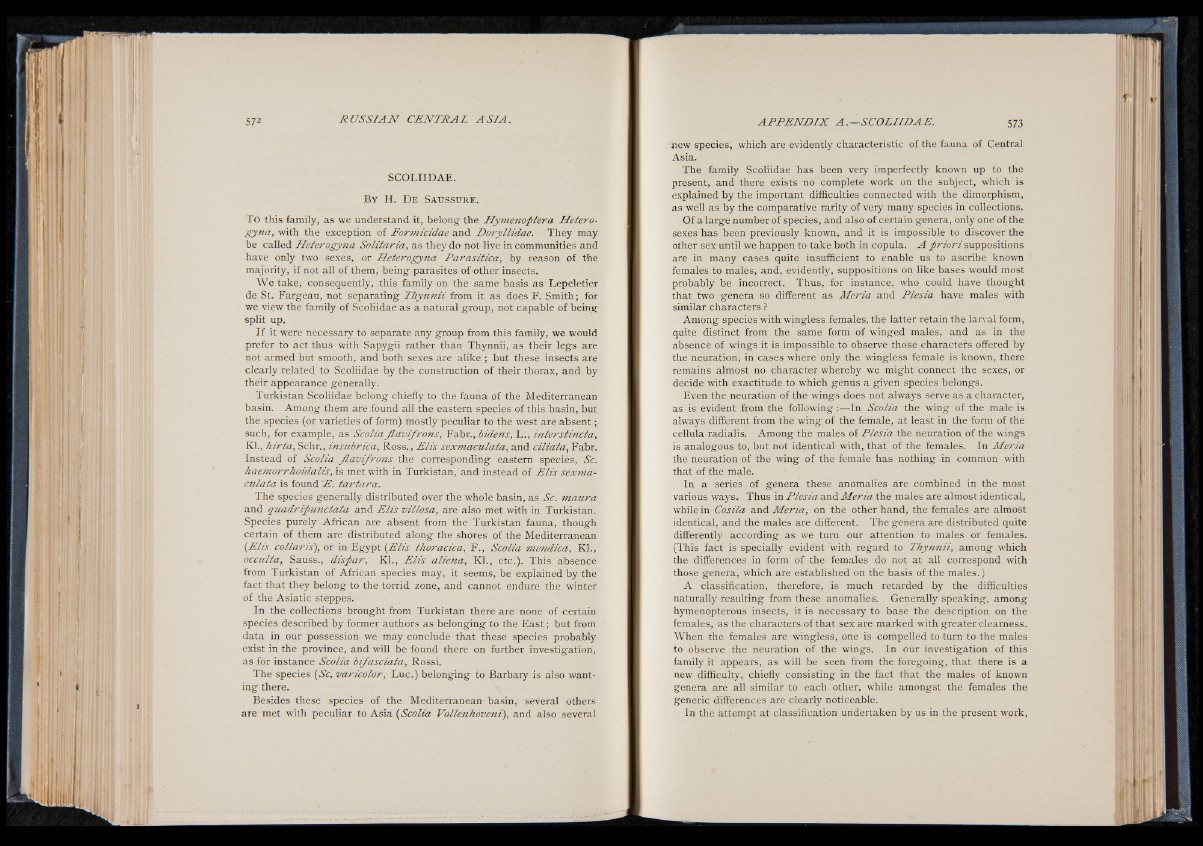
SCOLIIDAE.
B y H. D e Sa u s s u r e .
To this family, as we understand it, belong the Hymenoptera Heterogyna,
with the exception of Formicidae and Doryllidae. They may
be called Heterogyna Solitaria, as they do not live in communities and
have only two sexes, or Heterogyna Parasitica, by reason of the
majority, if not all of them, being parasites of other insects.
We take, consequently, this family on the same basis as Lepeletier
de St. Fargeau, not separating Thynnii from it as does F. Smith; for
we view the family of Scoliidae as a natural group, not capable of being
split up.
If it were necessary to separate any group from this family, we would
prefer to act thus with Sapygii rather than Thynnii, as their legs are
not armed but smooth, and both sexes are alike ; but these insects are
clearly related to Scoliidae by the construction of their thorax, and by
their appearance generally.
Turkistan Scoliidae belong chiefly to the fauna of the Mediterranean
basin. Among them are found all the eastern species of this basin, but
the species (or varieties of form) mostly peculiar to the west are absent;
such, for example, as Scolia Jlavifrons, Fabr., bidens, L., interstincta,
Kl., hirta, Schr., insubrica, Ross., E lis sexmaculata, and ciliata, Fabr.
Instead of Scolia Jlavifrons the corresponding eastern species, Sc.
haemorrhoidalis, is met with in Turkistan, and instead of E lis sexmaculata
is found 'E. tartara.
Thé species generally distributed over the whole basin, as Sc. maura
and quadr Ju n e tata and E lis villosa, are also met with in Turkistan.
Species purely African are absent from the Turkistan fauna, though
certain of them are distributed along the shores of the Mediterranean
(E lis collaris), or in Egypt (E lis thoracica, F., Scolia mendica, Kl.,
occulta, Sauss., d isfa r, Kl., E lis aliena, Kl., etc.). This absence
from Turkistan of African species may, it seems, be explained by the
fact that they belong to the torrid zone, and cannot endure the winter
of the Asiatic steppes.
In the collections brought from Turkistan there are none of certain
species described by former authors as belonging to the East; but from
data in our possession we may conclude that these species probably
exist in the province, and will be found there on further investigation,
as for instance Scolia bifasciata, Rossi.
The species (Sc. varicolor, Luc.) belonging to Barbary is also wanting
there.
Besides these species' of the Mediterranean basin, several others
are met with peculiar to Asia (Scolia Vollenhoveni), and also several
hew species, which are evidently characteristic of the fauna of Central
Asia.
The family Scoliidae has been very imperfectly known up to the
present, and there exists no complete work on the subject, which is
explained by the important difficulties connected with the dimorphism,
as well as by the comparative rarity of very many species in collections.
Of a large number of species, and also of certain genera, only one of the
sexes has been previously known, and it is impossible to discover the
other sex until we happen to take both in copula. A p r io ri suppositions
are in many cases quite insufficient to enable us to ascribe known
females to males, and, evidently, suppositions on like bases would most
probably be incorrect. Thus, for instance, who could have thought
that two genera so different as Meria and Plesia have males with
similar characters ?
Among species with wingless females, the latter retain the larval form,
quite distinct from the same form of winged males, and as in the
absence of wings it is impossible to observe those characters offered by
the neuration, in cases where only the wingless female is known, there
remains almost no character whereby we might connect the sexes, or
decide with exactitude to which genus a given species belongs.
Even the neuration of the wings does not always serve as a character,
as is evident from the following f^ In Scolia the wing of the male is
always different from the wing of the female, at least in the form of the
cellula radialis. Among the males of Plesia the neuration of the wings
is analogous to, but not identical with, that of the females. In Meria
the neuration of the yung of the female has nothing in common with
that of the male.
In a series of genera these anomalies are combined in the most
various ways. Thus in Plesia and Meria the males are almost identical,
while in Cosila and Meria, on the other hand, the females are almost
identical, and the males are different. The genera are distributed quite
differently according as we turn our attention to males or females.
(This fact is specially evident with regard to Thynnii, among which
the differences in form of the females do not at all correspond with
those genera, which are established on the basis of the males.)
A classification, therefore, is much retarded by the difficulties
naturally resulting from these anomalies. Generally speaking, among
hymenopterous insects, it is necessary to base the description on the
females, as the characters of that sex are marked with greater clearness.
When the females are wingless, one is compelled to turn to the males
to observe the neuration of the wings. In our investigation of this
family it appears, as will be seen from the foregoing, that there is a
new difficulty, chiefly consisting in the fact that the males of known
genera are all similar to each other, while amongst the females the
generic differences are clearly noticeable.
In the attempt at classification undertaken by us in the present work,